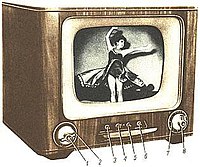
Photo from wikipedia
Abstract Objective A correlational study examined relationships among driving styles, 4 subfactors of desire for control, illusion of control, accident concern, self-rated likelihood of being involved in an accident, self-rated… Click to show full abstract
Abstract Objective A correlational study examined relationships among driving styles, 4 subfactors of desire for control, illusion of control, accident concern, self-rated likelihood of being involved in an accident, self-rated driving skill, and self-reported accidents, violations, and close calls. Methods An online sample of participants (N = 601) completed (1) the Multidimensional Driving Style Inventory (MDSI); (2) the Desirability of Control Scale (DCS); (3) an Illusion of Control Scale; (4) an accident concern self-rating, (5) a 3-item speed questionnaire; (6) a 4-item accidents, violations, and close calls questionnaire; (7) a driving skill self-rating; and (8) a demographic questionnaire. Scales were analyzed using exploratory factor analysis where appropriate. Exploratory correlational analyses examined relationships among factor scores for subscales and other variables of interest. Results The MDSI factored into 6 distinct driving styles, and the DCS factored in 4 subfactors of desire for control. Relationships among driving styles and other variables were used to create profiles of each of 6 driving styles—angry, anxious, cautious, dissociative, risky, and stress reduction—based on relationships among variables examined. Conclusions Our results may help to identify traits that are related to driving behaviors. In general, our results showed that several maladaptive driving styles (dissociative, risky, and angry) were negatively correlated with 2 subscales of desire for control (desire to proactively seek control and desire to control making decisions) and positively correlated with illusion of control. Cautious driving style, which is adaptive, showed the opposite pattern. We also produced evidence to support the construct validity of the MDSI and added to the growing literature suggesting that the MDSI factors into 6 distinct driving styles.
Journal Title: Traffic Injury Prevention
Year Published: 2021
Link to full text (if available)
Share on Social Media: Sign Up to like & get
recommendations!